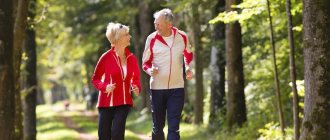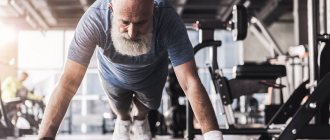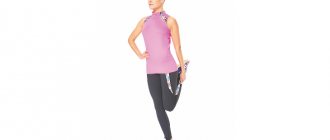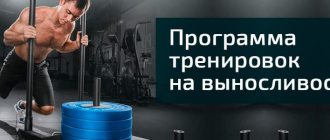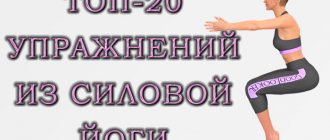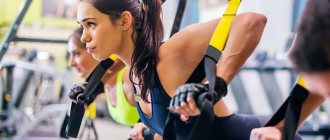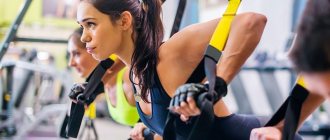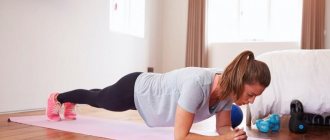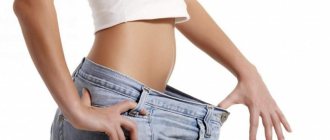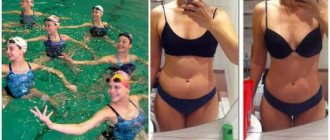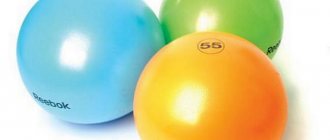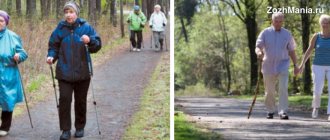In youth, when hormonal levels are high, the male body responds better to high-intensity training - strength training, with heavy weights and a small number of repetitions.
Article on the topic Contraindications for fitness: who should not play sports But women, on the contrary, tolerate endurance training better.
However, after 50 years, the production of hormones in men decreases, and in women, the proportion of male and female hormones also changes - the latter becomes smaller.
Thus, after fifty, everyone has common problems: muscle mass in the limbs is lost (arms and legs become thin), and fat is gained in the center of the body (on the stomach and buttocks). At the same time, men's ligaments and joints weaken, so it is no longer worth training in a strength mode, as in youth.
Nevertheless, men are rarely interested in a purely female complex for problem areas with an emphasis on the hips, so we offer them our training.
Pullover
Photo: AiF / Eduard Kudryavitsky
This exercise strengthens the pectoral muscles, back, upper shoulder girdle and develops the collar area.
Lie on your back on the sofa so that your hands, when you lower them behind your head, are completely above the empty space. Take the same position as for the previous exercise: knees bent, lower back pressed against the sofa, arms with dumbbells above your chest. Connect your fists and do not open them until the end of the exercise. Bend your elbows slightly so that they feel soft. Without bending further, lower both hands behind your head as deeply as possible and return to the starting position.
Repeat 2 times 15 times.
What exercises should you avoid after 50?
Extension of the lower leg in the simulator
This exercise puts unnecessary stress on the knee joints. Instead, perform squats without weights or with a light weight.
Photo: istockphoto.com
Pull-ups or head pulls
These exercises put additional stress on the shoulder joints. As an alternative, the trainer recommends doing rows and pull-ups.
Plyometric exercises (jumping)
They place a lot of stress on the joints.
Military Press and Dumbbell Overhead Presses
Lifting weights directly overhead, such as military presses or dumbbell presses (exercises for both shoulders), places enormous stress on the shoulders and rotator cuff tendons. Since rotator cuff injuries are most common after age 60, use shoulder abductions or forward raises instead of overhead presses.
All ages are submissive: what sports can you start doing after 30?
Heavy weights
If in your younger years, exercising with weights helps you believe in yourself and increase your self-esteem, then in old age this loses its relevance. It also increases the risk of injury.
For exercises that can be performed at any age, see the “Championship” video.
Well
Photo: AiF / Eduard Kudryavitsky
Squats are the best exercise for the legs and buttocks. However, classic squats put a lot of stress on the knees and lower back. After 50, men should start with a lighter version.
Place two chairs on either side of you. Stand straight with your feet shoulder-width apart. Hands on the belt. Squat down, moving your pelvis back and lowering your body slightly forward. After going through about half the amplitude, lower your hands with your palms on the seats of the chairs. Continue the squat to the bottom, leaning lightly on your palms. Start to rise, also leaning on your hands; as you rise, remove them from the chairs and place them on your waist.
Repeat 20 times.
UZ "Mogilev City Emergency Hospital"
Life is a precious gift, which in young and mature years a person often disposes of frivolously. As long as he has strength and health, he does not limit himself in activity, exposing the body to excessive stress. But a person gradually ages. Aging and old age are not the same thing. Aging begins relatively early and often goes unnoticed. Already from the age of 25-30, changes begin in the body; from the age of 50 they already appear noticeably.
Aging is a destructive process in the body that inevitably develops with age as a result of the increasing damaging effects of external factors and leading to a lack of physiological functions of the body. Muscle flaccidity is the first signal of the onset of aging. To maintain their tone, regular physical activity is necessary.
Old age is a period of life that is a consequence of the aging process. Age gradations for older ages: elderly - 60-74 years, senile - 75-89 years, long-lived - 90 years and older.
In general, society is “aging”: the number of older people in it is increasing. A person, as a rule, does not live to his biological age. The living conditions of modern society, especially diseases that are widespread in the second half of life - atherosclerosis, ischemic heart disease, arterial hypertension, diabetes mellitus, etc., lead to premature aging.
I.I. Mechnikov, rightfully revered as the father of Russian gerontology, said: “A long life is not valuable in itself, but only when it coincides with the preservation of physical and mental abilities.” Numerous examples of longevity and the results of scientific research give the right to believe that the limit of human life is approaching 100-120 years. What's the most beautiful thing in the world? Old head and young heart.
In the sixth decade, attitudes towards one’s own capabilities change. Acquired illnesses and problems characteristic of this particular age make themselves felt. Many people think something like this: since age-related ailments are inevitable, it is necessary to moderate your ardor and submit to circumstances. People begin to move less and take more medications, believing that in this way they save energy and help the body cope with the transition to a new lifestyle. However, such a position is a harmful misconception.
And in old age, life can be full, full of vivid sensations and events, i.e. almost as active as in previous years. It is only important to have a good idea of what physiological changes are occurring in the body at a given period of time, and in accordance with this, adjust (and not radically change!) your daily behavior style, diet, etc.
In the period “over 60”, not only a restructuring of some functions occurs in the direction of their inhibition and subsequent extinction, but a counter process is also observed: the body actively resists negative phenomena. Therefore, restrictions at this age should not be absolute, but reasonable, aimed at prolonging a vigorous and active state until old age.
Physical activity becomes of paramount importance: in organs, muscles and vessels that receive a feasible load, metabolism increases, i.e. nutrition of cells, and they stay healthy longer.
As for specific diseases of the elderly, their list is quite extensive, however, these ailments are not as fatal as is sometimes thought. Some of these diseases can be successfully prevented. Others are effectively treated with a healthy diet, a structured active lifestyle, herbal remedies and exercise. The desire of the patient himself to overcome the disease is of great importance.
Advice for elderly patients: before starting regular exercise, it is advisable to consult a physical therapist.
Science and everyday practice have proven that even moderate physical activity can slow down the aging process, improve the functioning of the cardiovascular system, respiratory system, increase muscle strength and mobility in the joints, increase bone density, and reduce susceptibility to depression.
The primary goal of health training is to increase the level of physical condition to values that guarantee safe human health.
For those who have never exercised, you need to start with a small number of exercises and their repetitions.
Principles of physical education:
1. Gradual increase in load - go “from simple to complex” and “from less to more.”
2. Constant and regular physical activity throughout the week.
3. Correct execution of movements.
Movement itself does not provide health. Only “correct movement” brings health, i.e. correct selection of a complex of physical activity, which includes strength, stretching and aerobic exercises.
Be sure to do morning exercises. Exercise is a warm-up before the working day. First, simple exercises are performed for the legs and back while lying on the bed. Then, getting out of bed, do exercises for the arms and shoulder girdle. Preferably 15-20 repetitions of each movement. Exercises should be done not only in the morning, but also in the evening to relieve fatigue.
The cardiovascular system is one of the first to respond to physical activity. The flow of blood (and oxygen) increases not only to the skeletal muscles, but also to the heart.
Metabolism in tissues increases. The positive effect of physical education on the central nervous system: increased performance, improved mood, coordination of movements.
Self-monitoring of the state of the cardiovascular system is mandatory. First, you need to measure your heart rate at rest, before performing exercises, and calculate the maximum permissible heart rate using K. Cooper's formula: 220 - age . For example, for a 60-year-old person, 220 - 60 = 160. The optimal heart rate during exercise is 80% of the maximum heart rate. For a person 60 years old - 128 beats per minute. If he raises and maintains his pulse in this mode for at least 20 minutes 4 times a week, then he gets a good aerobic (health-improving) effect.
It is also important to count your pulse during exercise and 5 minutes after completing it (a good result is a 50% reduction in heart rate).
Physical exercises should be performed in sets throughout the day. This will prevent overload of the cardiovascular system, and the training effect will be given by the total number of repetitions per day. After physical activity, muscle stretching exercises are performed.
Walking down the street is encouraged, as it is the most physiological exercise for the heart. You can always find time for walking. Don't use the elevator, take the stairs, walk to work. It is important to remember that walking must be fast, only then will it have a training effect. But for people with diseases of the leg joints, long walking and squats are not recommended. They are shown special exercises for the legs while sitting and lying down.
Exercise now, today! Don’t put it off for old age, for retirement, when “time appears”, but at the same time your health suddenly disappears! (S.M. Bubnovsky).
Your physical therapy doctor
I.Yu.Isaeva
Lying dumbbell flyes
Photo: AiF / Eduard Kudryavitsky
Photo: AiF / Eduard Kudryavitsky
Photo: AiF / Eduard Kudryavitsky
This exercise gives volume and at the same time elasticity to the pectoral and shoulder muscles.
Article on the topic
Men's health: trained muscles are young until old age (04/30/2013) Loss of elasticity and resulting injuries are another problem for older men.
Lying on your back, bend your legs and place your feet on the floor so that your lower back is pressed to the floor. Take the dumbbells in your hands and lift them above your chest.
Bend your elbows slightly and spread your arms out to the sides with your elbows down so that your elbows touch the floor first, and a little later your hands almost touch. That is, there seems to be a large ball between the hands.
The hands should not fall below the elbows at all stages of movement, and do not lift the lower back off the floor - all this is fraught with injury.
Then, in the reverse order, raise your hands and elbows, bringing your arms straight above you.
Repeat 25-30 times.
About metabolic training
Are you interested? Then let's begin! A person is often faced with a choice: oatmeal or an omelet, sneakers or heels, strength or cardio training. The last two definitions are in constant confrontation in fitness. Cardio helps burn calories, strength exercises create beautiful relief and speed up metabolism.
If you have to make a choice, then try a metabolic program that combines the best of these two techniques.
This is how Equinox Club (New York) instructor Frank Salzone characterizes the new workout. According to him, metabolic training is a synthesis of short but intense exercises that force all the muscles a person has to work.
A person develops power, strength, endurance even in one lesson. Calorie burning occurs not only during training, but also after it ends.
Moreover, during exercise, the muscles learn to use their energy in such a way that in the future a person is able to work harder and more intensely, constantly improving his performance.
Sounds too tempting. But believe me, this is not fiction. Several studies were conducted, the results of which were published in one popular sports publication.
What did they show? It turned out that an extremely high level of metabolism was noted in those women who trained according to this program. Their results were better than those of those ladies who practiced according to the usual method.
It turned out that in the first group, calorie burning occurred even 16 hours after completion of training, that is, already at rest.
Pull against the wall
Photo: AiF / Eduard Kudryavitsky
Standing dumbbell row is one of the best exercises for the back. However, beginners in adulthood need to take care of the spine, so we do this exercise against the wall.
Article on the topic
Fitness for men: how to persuade him to play sports Instead of dumbbells, you can use plastic cans of water.
Stand with your back to the wall. Press your tailbone, move your feet 10–15 cm. Take dumbbells in your hands, straighten up, press your shoulder blades, shoulders and the back of your head against the wall.
Smoothly, maintaining the same deployed position of the shoulder blades and shoulders, without lowering the chin, tilt the body forward. The tailbone does not come off the wall!
Hands with dumbbells should drop to just below your knees. Return to the starting position, again pressing your shoulder blades and the back of your head against the wall.
Repeat 20 times.
What is training for men over fifty?
The workout for men over 50 consists of exercises using your own body weight, dumbbells and kettlebells. These workouts can be done at home. The exercises are performed in circuit training mode with moderate weight.
The main goal of training is to tone the muscles and improve the quality of life by developing and maintaining the normal functioning of the body and its systems.
You can train every third day or less. The frequency of training depends on your level of training and well-being. Also, the training method (circular) can be changed to performing exercises in sets. But in this article we will look at circuit training.
Crunches
Photo: AiF / Eduard Kudryavitsky
Photo: AiF / Eduard Kudryavitsky
This classic exercise for the abdominals must be performed without lifting the lower back from the floor, otherwise there is a risk of damaging it.
Lying on your back, bend your knees and place your feet on a wall or rest your heels on the seat of a chair. Hands under the neck. As you exhale, lower your chin to your chest and stretch your forehead forward, twisting your back so that your shoulders and possibly your shoulder blades lift off the floor. In this case, the lower back should press harder to the floor. As you inhale, return to the starting position.
Repeat 2 times 10-15 times.
